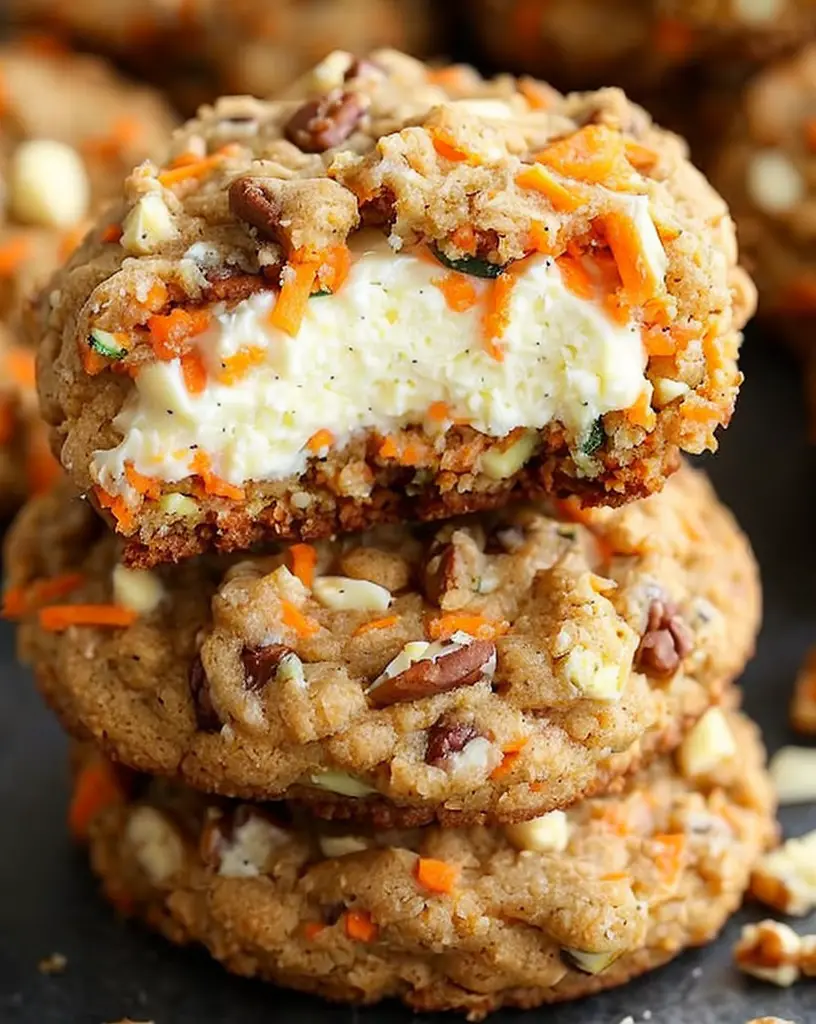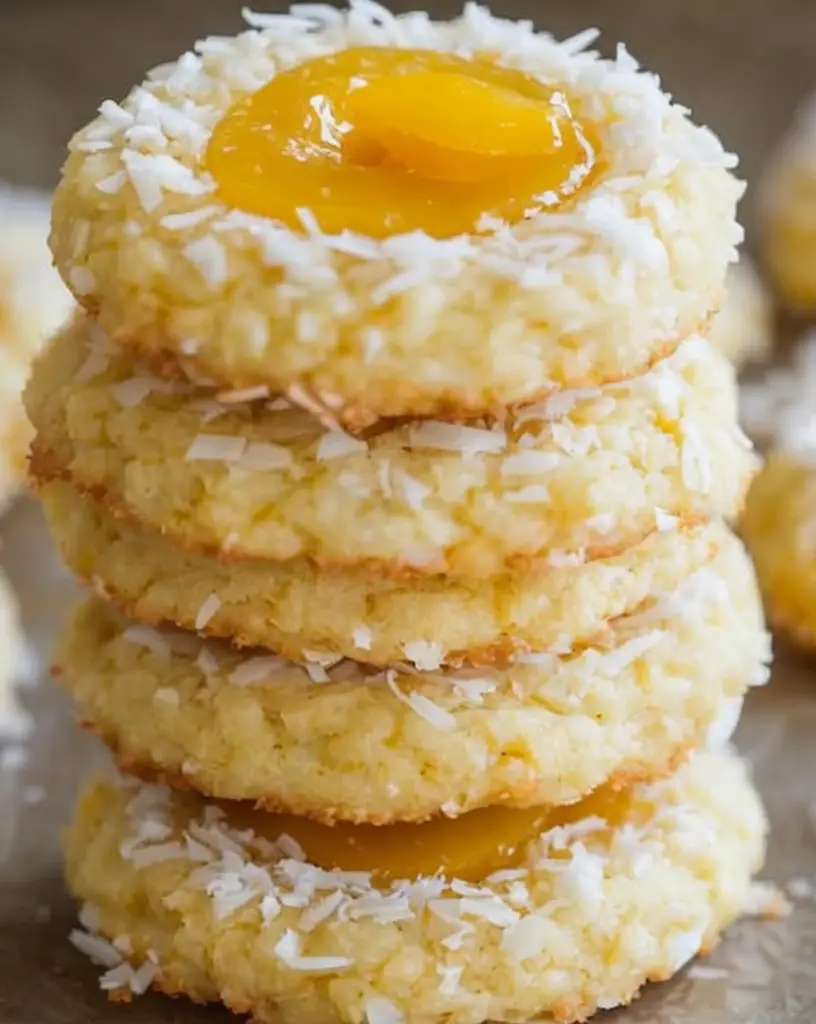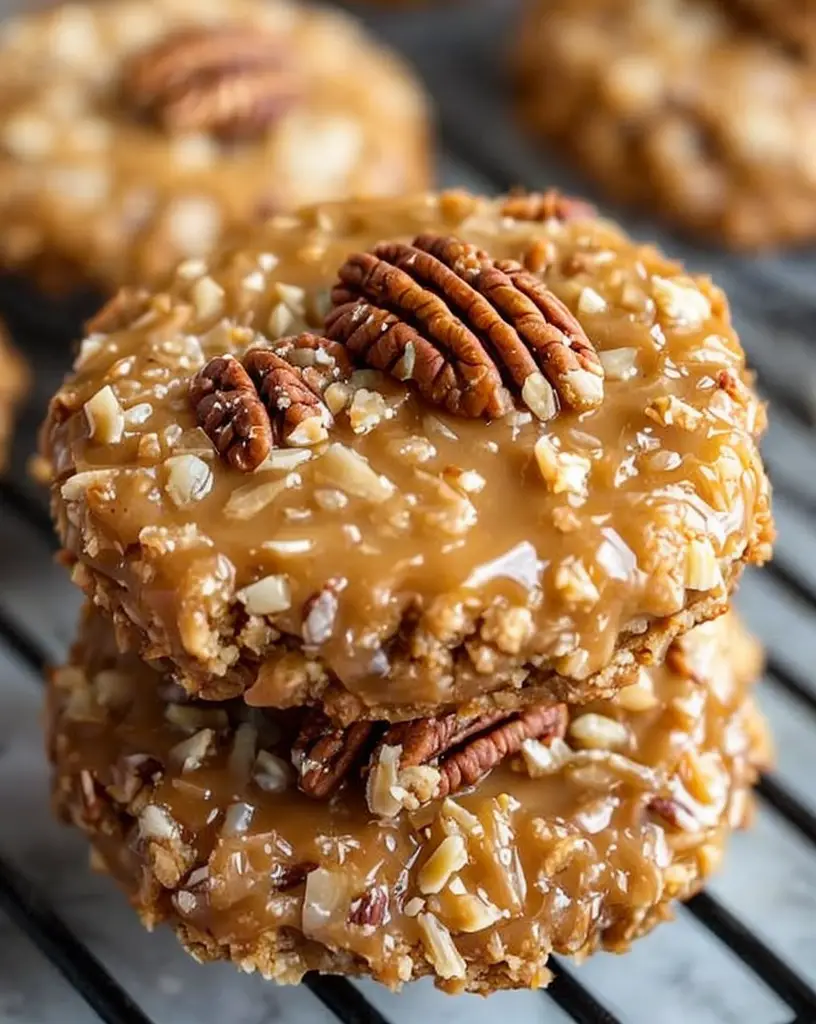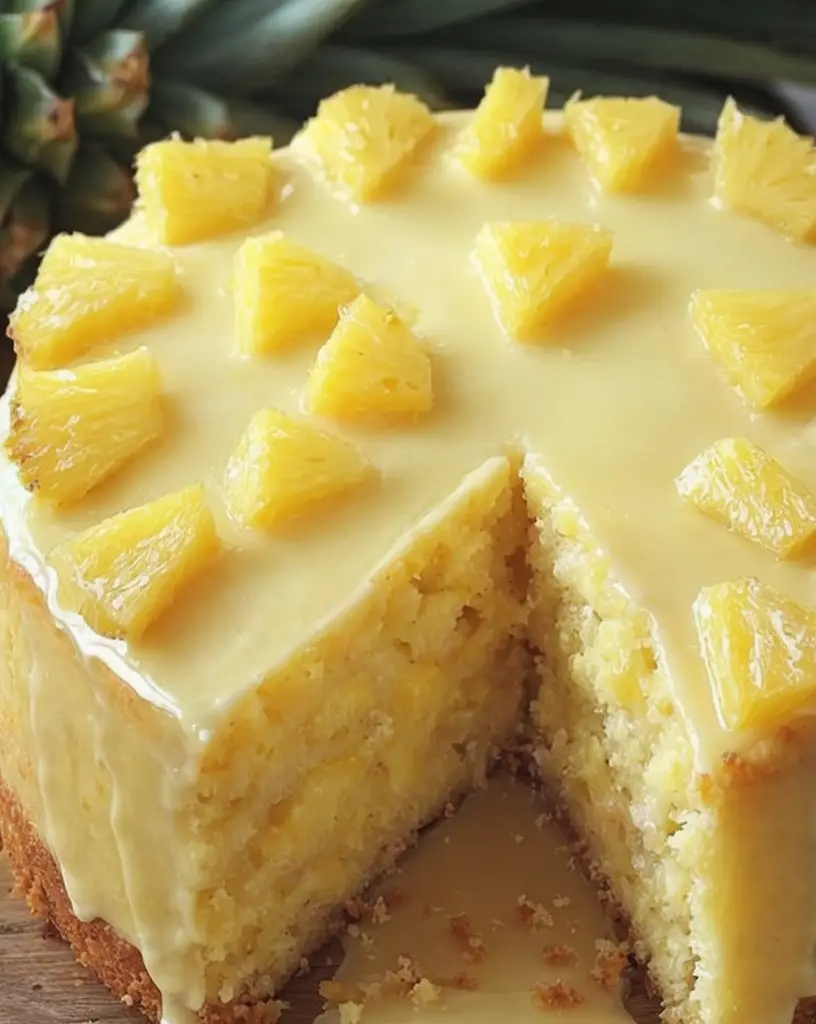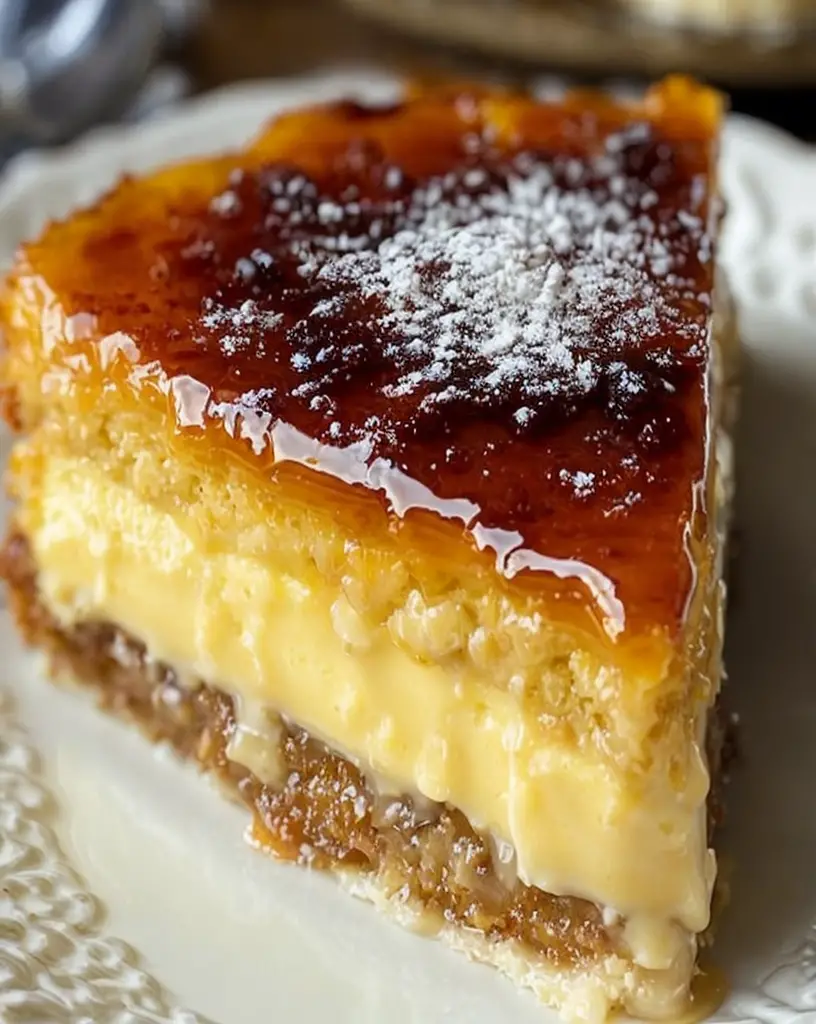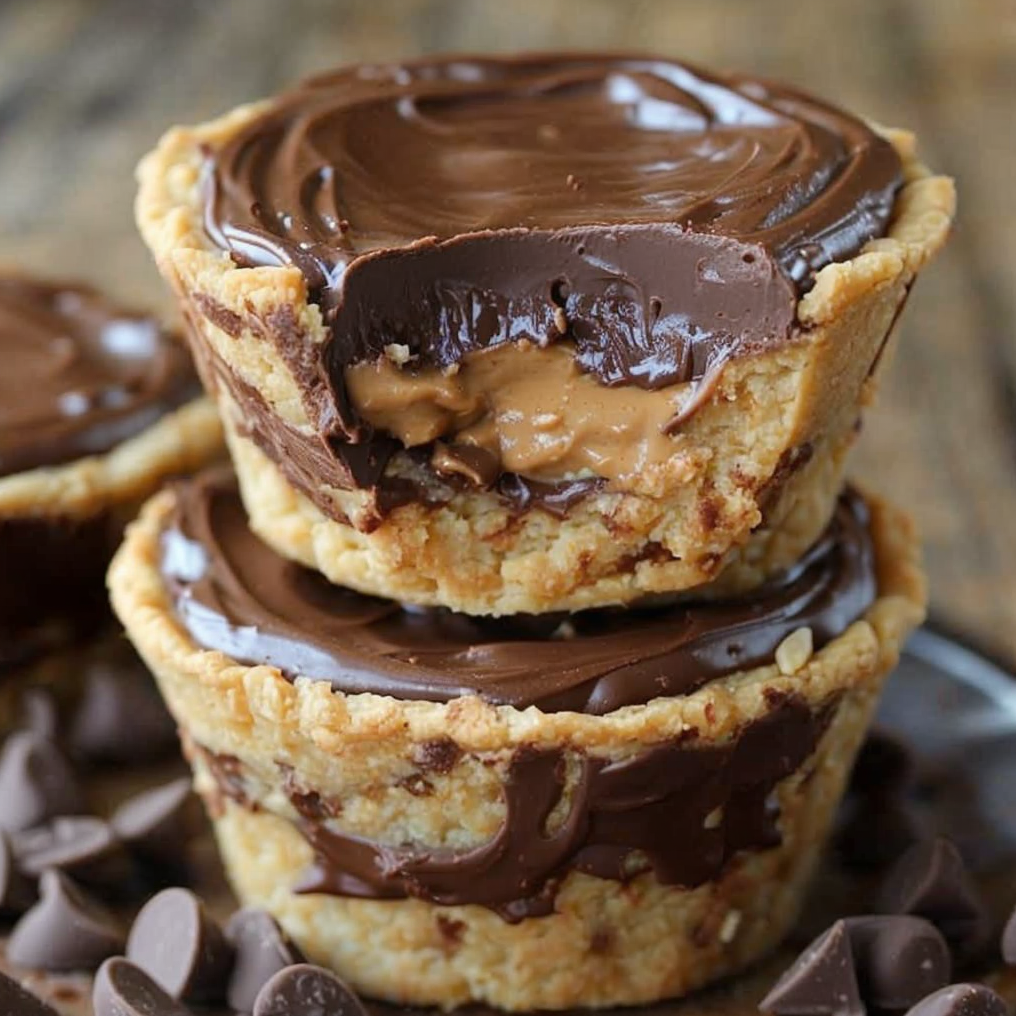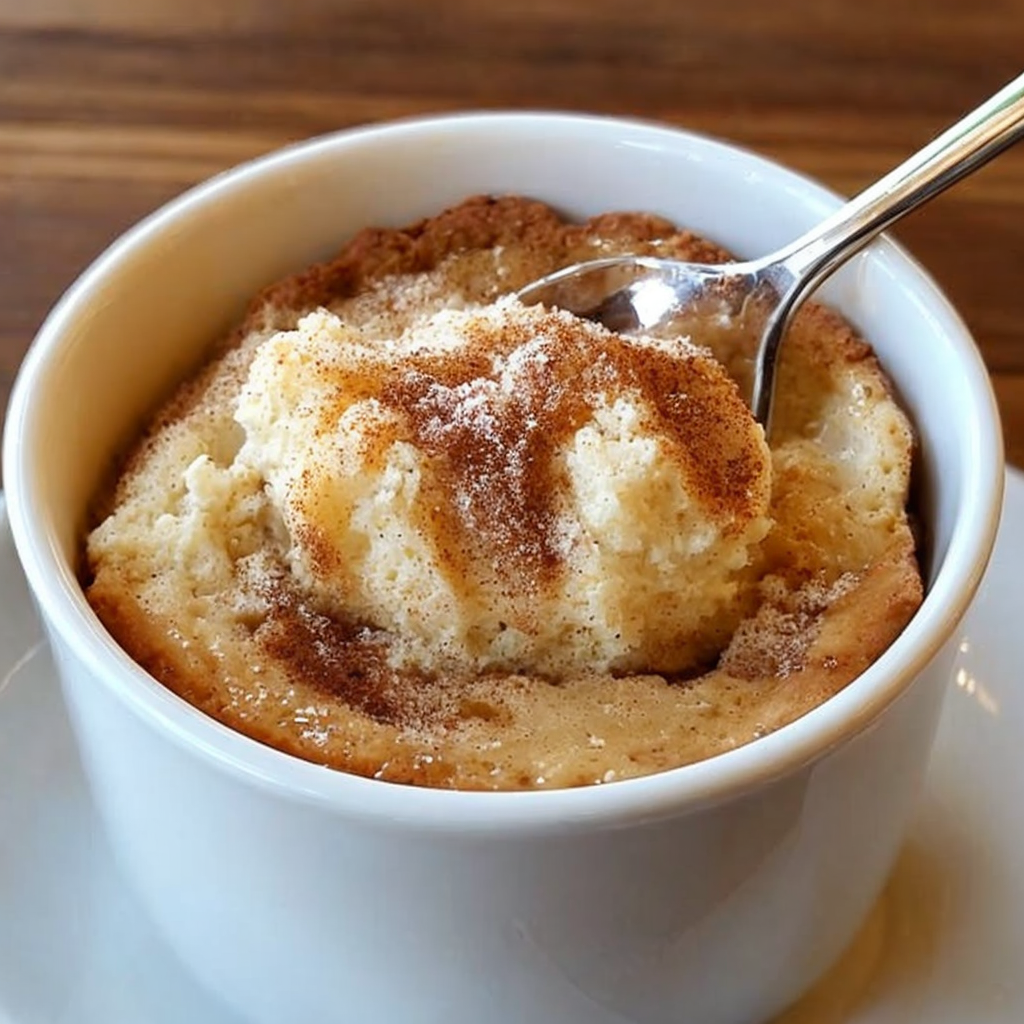Zucchini Carrot Cake Cheesecake Cookies: A Delicious Twist on Classic Flavors
Welcome to the ultimate indulgence: Zucchini Carrot Cake Cheesecake Cookies! This unique recipe perfectly marries the flavors of zesty carrots, subtle zucchini, and creamy cheesecake all wrapped into a delightful cookie form. Imagine the tantalizing fusion of spices that dancing through your taste buds with each bite, creating an unforgettable treat that is both comforting and sophisticated. Perfectly moist and delightfully chewy, these cookies also boast a luscious cheesecake center, making them perfect for any occasion, whether it’s a family gathering, potluck, or just a sweet treat to enjoy at home.
These Zucchini Carrot Cake Cheesecake Cookies not only satisfy your sweet tooth but also add a hint of nostalgia with their playful, cake-like texture. Each cookie is an invitation to enjoy the delightful complexities of flavors with every satisfying chewy bite. The addition of fresh vegetables provides a naturally sweet and moist base, allowing you to enjoy all the decadent flavors guilt-free. Bring joy to your kitchen and delight to your taste buds with this simple yet extraordinary recipe!
Quick Recipe Highlights
- Flavor Profile: Expect sweet notes from the carrots, earthy undertones from zucchini, and a rich creaminess from the cheesecake filling.
- Texture: These cookies present a soft, chewy exterior with a luscious, creamy center that melts in your mouth.
- Aroma: The warm spices of cinnamon and nutmeg create an inviting aroma that fills your kitchen.
- Visual Appeal: Vibrant orange and green flecks combined with a glistening cream filling make these cookies eye-catching.
- Skill Level Needed: This recipe requires basic baking skills but is accessible for both novice and experienced bakers.
- Special Equipment: A mixer, baking sheets, and parchment paper will make the process easier and more efficient.
Recipe Overview
- Difficulty Level: This recipe is considered medium due to the multiple components involved, but is manageable with clear instructions for each step.
- Category: These cookies are a delightful dessert that can also double as a lavish snack throughout the day.
- Cuisine: This recipe draws from American baking traditions, blending classic carrot cake and cheesecake elements into a new format.
- Cost: Ingredients are generally affordable, with the most significant expense being the cream cheese.
- Season: These cookies are perfect for any season, especially spring and summer when fresh zucchini is abundant.
- Occasion: Ideal for celebrations, casual gatherings, or as a creative treat for lunch boxes.
Why You’ll Love This Recipe
The combination of zesty flavors and soothing textures make these Zucchini Carrot Cake Cheesecake Cookies a fan favorite. The natural sweetness from the carrots and zucchini offers a unique taste profile that pairs beautifully with the creamy cheesecake interior. Each bite provides the perfect balance of sweetness and warmth, making them an irresistible indulgence for dessert lovers.
Convenience sets this recipe apart; it’s relatively quick to prepare and doesn’t require overly complicated techniques. Simply mix, scoop, and bake! For those busy days or last-minute gatherings, you can whip up these cookies in no time, offering a delicious surprise that impresses every guest.
Nutritionally, adding zucchini and carrots boosts the health factor of these cookies. Both vegetables contribute essential vitamins, minerals, and fiber while allowing you to sneak in some veggies into your treats. This makes them a little more wholesome compared to traditional cookies without sacrificing flavor.
Socially, these cookies serve as a great conversation starter. Their unique flavor and presentation will captivate your guests’ attention, encouraging them to savor and discuss this innovative take on classic desserts. Plus, they’re perfect for sharing with friends and family, helping to create memorable moments around the table.
Cost-effectiveness plays a role too. Using everyday ingredients, this recipe allows you to create impressive treats without breaking the bank. With a yield of about 24 cookies, you’re sure to have plenty to share or enjoy throughout the week!
Historical Background and Cultural Significance
The idea of combining zucchini and carrots in baked goods has roots in traditional home cooking, where frugal cooks sought to utilize seasonal produce effectively. Carrot cake, in particular, has a rich history dating back to medieval Europe when it was popular to sweeten baked goods with carrots instead of sugar. With the rise of American baking, this concept evolved, inspiring various renditions like zucchini bread, which became a staple in many households.
In America, the carrot cake gained immense popularity in the late 20th century, often enjoyed at celebrations such as birthdays and weddings. The use of zucchini in baking surged with the growth of community gardening, showcasing how people creatively used seasonal vegetables. Combining these two beloved ingredients reflects a trend in modern baking, where creative combinations are celebrated.
As recipes evolve, many aspects of the traditional carrot cake recipe have been modified, including healthier alternatives using whole grains and less sugar. The introduction of cheesecake elements adds another layer, celebrating the rich, creamy textures found in many beloved desserts.
Regional variations of carrot cake exist, with different spices, nuts, and frostings capturing the essence of local culinary traditions. Adding zucchini to the mix demonstrates the flexibility and creativity in American baking, illustrating how home cooks turn simple ingredients into delightful desserts.
Ingredient Deep Dive
In this recipe, zucchini serves not just as a filler but an important ingredient that adds moisture without overwhelming flavor. An excellent source of vitamins A and C, zucchini also provides a subtle, mild flavor that complements the sweetness of carrots. When selecting zucchini, look for firm, unblemished vegetables with a vibrant skin. For storage, keep zucchini in the fridge’s vegetable drawer for up to a week.
Carrots, a staple in many kitchens, add natural sweetness and a lovely orange hue to these cookies. Carrots are high in beta-carotene, an antioxidant that is converted to vitamin A in the body, aiding in vision and skin health. When choosing carrots, opt for smooth, firm specimens, avoiding those that feel soft. Store them in the refrigerator in a perforated plastic bag to keep them fresh longer.
Cream cheese provides the luscious cheesecake filling that steals the show in these cookies. Rich and creamy, it adds a delightful tang that balances the sweetness of the cookie. When selecting cream cheese, choose full-fat versions for best results, and store leftovers wrapped tightly in the fridge up to a week.
Flour is a foundational ingredient, offering structure and stability to the cookies. All-purpose flour usually produces great results, but for a nuttier flavor and denser texture, consider whole wheat flour. Always sift your flour before measuring to ensure accuracy in your cookie dough.
Sugar sweetens these delightful creations and also contributes to the cookies’ texture. A blend of brown and granulated sugar adds depth to the flavor profile. When making substitutions, consider alternatives like honey or maple syrup, but keep in mind that liquid sweeteners may alter the moisture balance.
Common Mistakes to Avoid
- Overmixing the dough: This can lead to tough cookies. Mix just until combined to keep your cookies soft and chewy.
- Using too much moisture: Excess water from zucchini can make your cookies overly wet. Squeeze out excess moisture before adding it to the batter.
- Overbaking: Keep an eye on the baking time. Cookies should be lightly golden around the edges, but soft in the center.
- Not chilling the dough: Allowing the dough to chill before baking can enhance the flavors and improve texture.
- Skipping parchment paper: Using it can prevent sticking, ensuring your cookies release effortlessly from the baking sheet.
- Ignoring oven temperature: An oven thermometer can help ensure your cookies bake correctly and thoroughly.
- Not measuring accurately: Use measuring cups and spoons for precise measurements to yield consistent results.
- Storing improperly: To maintain freshness, store cookies in an airtight container at room temperature. Refrigeration can lead to changes in texture.
Essential Techniques
To achieve the perfect Zucchini Carrot Cake Cheesecake Cookies, proper technique is crucial. Start by creaming the butter and sugars together until light and fluffy; this process incorporates air into the mixture, contributing to a lighter texture. Be careful not to overmix after adding the dry ingredients, which could lead to dense cookies.
Also, ensure the cream cheese filling is smooth before incorporating it into the cookie. If using chilled cream cheese, it may lead to lumps in the filling. Let it come to room temperature for a consistent mixture that blends beautifully into your cookie dough.
Regarding baking, pay special attention to oven temperatures. An accurate temperature will ensure the cookies bake evenly. If you find the tops of your cookies are browning too quickly, consider rotating the baking sheet halfway through for an even cook.
Pro Tips for Perfect Zucchini Carrot Cake Cheesecake Cookies
To achieve cookie perfection, start with room temperature ingredients, which can impact the final texture dramatically. This includes eggs, butter, and cream cheese, ensuring they mix more uniformly.
Consider adding chopped walnuts or pecans to your cookie dough for an additional crunch that contrasts beautifully with the soft cookie texture. These enhance flavor and provide a nutty richness that complements the other ingredients.
Experiment with spices. While cinnamon is a classic, consider adding a dash of ginger or a pinch of allspice for added warmth and depth. It can elevate flavors to new levels.
Utilize a cookie scoop for uniformity in size, allowing all cookies to bake evenly. It also simplifies portioning, preventing you from over or under-filling your cookies.
For an extra layer of flavor, drizzle a simple icing glaze made from powdered sugar and milk over cooled cookies, enhancing both flavor and visual appeal.
Wait until cookies have cooled on the baking sheet for a few minutes before transferring them to wire racks. This allows them to set properly, preventing crumbling during the transfer.
Finally, store cookies in an airtight container with parchment paper between layers to prevent sticking and keep them fresh longer.
Variations and Adaptations
These Zucchini Carrot Cake Cheesecake Cookies can be tailored to suit different tastes and dietary needs. For a seasonal twist, consider incorporating grated apples or pumpkin puree for a delightful flavor shift.
Vegan adaptations can be achieved by replacing eggs with flaxseed meal or applesauce, and substituting cream cheese with a vegan cream cheese alternative. This maintains the essence of the recipe while accommodating dietary preferences.
Gluten-free versions can be achieved by substituting all-purpose flour with a gluten-free flour blend. Just ensure the blend contains xanthan gum for structure; this is vital for maintaining the texture of your cookies.
Flavor variations are plentiful; try adding citrus zests like lemon or orange for a refreshing citrus contrast. You can also incorporate chocolate chips for an indulgent twist that chocolate lovers will adore.
For a unique texture, consider rolling the cookies in shredded coconut or chopped nuts before baking. This adds an exciting crunch and enhances the cookie’s visual appeal on the platter.
Finally, consider presenting these cookies on a beautiful tiered cake stand for an impressive display at gatherings; they become an eye-catching centerpiece at your dessert table.
Serving and Presentation Guide
Plating these cookies beautifully can elevate any event or gathering. Start by arranging the cookies on a beautiful platter, possibly accented with seasonal fruits or edible flowers for added color and interest.
Garnish with a drizzle of caramel or a sprinkle of powdered sugar over the top for a finishing touch that enhances visual presentation. Pair each cookie with a small scoop of vanilla ice cream or a dollop of whipped cream on the side for an elegant touch.
Consider creating a dessert bar where guests can assemble their own cookie sandwiches with cream cheese frosting, providing an interactive element at your event.
As for temperature, these cookies can be served warm or at room temperature. If serving them warm, be sure to let them sit for about 5 minutes after baking to prevent burns from the molten cheesecake center.
Finally, remember to consider portion control. These cookies can be quite rich; offering them in smaller sizes alongside a variety of other desserts encourages guests to sample and enjoy a wider array.
Wine and Beverage Pairing
Pairing beverages with Zucchini Carrot Cake Cheesecake Cookies can elevate your snack experience. A sweet Riesling complements the sweetness of the cookies while enhancing the spiced flavors beautifully.
For non-alcoholic options, consider serving a light ginger lemonade, which contrasts the cookies’ density and refreshes the palate. The spiciness of ginger in the drink pairs well with the warm spices used in the cookies.
If coffee is more your style, a rich espresso or lightly sweetened latte can enhance the creamy cheesecake filling while providing a balanced flavor profile that suits the cookies’ sweetness.
Ensure that beverages served are at the appropriate temperature. Chill white wines and serve coffees hot; this balance ensures a satisfying drinking and eating experience.
Bringing a variety of these choices to your next event keeps options open and allows everyone to find a pairing that suits their individual palate.
Storage and Shelf Life
When it’s time to store your Zucchini Carrot Cake Cheesecake Cookies, prioritize keeping them fresh and flavorful. Store them in an airtight container at room temperature for up to a week. If you require longer storage, consider refrigerating them where they can last for up to two weeks.
To prevent any texture loss, separate layers of cookies with parchment paper within the container. This practice helps air circulate, maintaining their delightful chewiness.
If you need to freeze any leftovers, wrap each cookie individually in plastic wrap and place them in a freezer-safe bag. They can be stored this way for up to three months. When ready to enjoy, simply thaw at room temperature or reheat gently in the microwave.
Look out for signs of spoilage, such as a sour smell or noticeable changes in texture. If the cookies appear dry or have developed mold, it’s best to discard them.
Reheating cookies is simple; consider using a low microwave setting or placing them in a preheated oven for a few minutes to restore their original texture.
Make Ahead Strategies
If you’re planning to make Zucchini Carrot Cake Cheesecake Cookies for an event, there are several strategies for preparation in advance. You can prepare the dough a day ahead and store it in the refrigerator, which allows the flavors to meld beautifully.
Consider baking half the batch and freezing the remaining dough for a quick treat at a later time. Shape the cookie dough, freeze the shapes on a baking sheet, then transfer to a freezer bag for later baking without thawing.
For those who enjoy hosting, prepare your filling and cookie dough separately, then assemble only when the time comes around. This method preserves freshness and allows you to customize the creamy filling by adding different flavors or spices.
Lastly, while you can bake cookies a day or two in advance, allow them to cool completely before storing. This prevents an undesired moisture lock that can impact the final texture.
Scaling Instructions
If you need to adjust the batch size of your Zucchini Carrot Cake Cheesecake Cookies, scaling is simple. To halve the recipe, divide each ingredient measurement in half, taking note that baking times may vary slightly.
If you’re looking to double or triple the cookie recipe, ensure you have a large enough mixing bowl and baking sheets. Consider an increased baking time, and remember to check for doneness, as larger batches may cook unevenly.
Equipment adjustments include using multiple baking sheets or working in batches to prevent overcrowding the oven. This helps maintain consistent temperature and timing for optimal results.
Be mindful of timing modifications, particularly if switching between small and large batches. Some adjustments might be necessary to ensure that all cookies achieve a proper bake.
When scaling, also consider your storage methods. Larger quantities may require more substantial containers for storage, ensuring that freshness is upheld across all cookies.
Nutritional Deep Dive
Analyzing the nutritional content of Zucchini Carrot Cake Cheesecake Cookies offers a delightful perspective on health benefits. Each cookie typically contains moderate amounts of carbohydrates, primarily sourced from natural ingredients such as carrots and zucchini.
You’ll find an interesting blend of macronutrients with healthy fats from butter and cream cheese, contributing to the delicious creamy center. These cookies provide protein as well, mainly from the eggs and cream cheese, aiding in muscle growth and repair.
Meanwhile, the micronutrient profile is worthy of note! Carrots deliver essential vitamins like A and K, while zucchini provides significant amounts of vitamins A and C. These nutrients support healthy vision, immune system function, and skin health.
Considering portion sizes is also vital—enjoying these cookies in moderation keeps your indulgence balanced and guilt-free. They offer a delightful treat that can fit into an overall healthy lifestyle when paired with nutrient-dense meals throughout the day.
Additionally, the fiber content from the vegetables promotes digestion, helping you feel satisfied without overeating. This enhances both the enjoyment and nutritional value of these sweet delights.
Dietary Adaptations
Accommodating diverse dietary preferences is a breeze with Zucchini Carrot Cake Cheesecake Cookies. For a gluten-free adaptation, consider using almond flour or a gluten-free blend to substitute regular flour, ensuring the texture remains soft yet sturdy.
For vegan enthusiasts, swap the eggs for flaxseed meal (1 tablespoon of flaxseed with 2.5 tablespoons water per egg) and replace cream cheese with a plant-based counterpart. These adjustments maintain flavor while catering to strict dietary guidelines.
If you’re looking for a lower-carb version, explore almond flour as a base and simply adjust sweeteners accordingly; using erythritol or similar alternatives can keep the sweetness without excess carbs.
For a Paleo approach, stick to whole food ingredients, using coconut oil in place of butter and combined alternatives for sweetening. Adjusting the recipe this way would not only fit within Paleo guidelines but offer an exciting flavor profile.
Those adhering to a low-FODMAP diet can omit certain ingredients or replace high FODMAP items with alternatives, maintaining digestive comfort. Always check product labels for hidden allergens.
The adaptability of this recipe demonstrates its versatility, making it suitable for a wide range of dietary needs without sacrificing flavor.
Troubleshooting Guide
If your Zucchini Carrot Cake Cheesecake Cookies face some roadblocks, don’t fret! Sometimes, texture issues can arise. If cookies turn out too cakey, it might be due to overly moist zucchini. Always ensure you squeeze out excess moisture before integrating it into the mix for optimal consistency.
Flavor balance can be another concern; if they seem bland, consider increasing the spices in your mix. Simply enhancing cinnamon or adding a dash of nutmeg can significantly elevate the final taste.
Temperature troubles might manifest if cookies burn on the outside while remaining undercooked in the center. Lower your oven temperature and allow for a longer baking time to achieve a perfect bake throughout.
Equipment challenges often come into play. If you don’t have a stand mixer, no need to panic! A sturdy hand mixer or even a whisk can work just fine—just ensure you’re ready to put in some extra effort.
Ingredient substitutions can cause issues; if you switch out cream cheese for a less fatty alternative, know that the texture may differ. Trial and error with substitutes is normal; keep meticulous notes for future attempts.
Lastly, maintain timing awareness during baking. If you’re adjusting quantities, it’s essential to keep an eye on the cookies, especially with larger batches to ensure even cooking throughout.
Recipe Success Stories
Many bakers have delighted in crafting Zucchini Carrot Cake Cheesecake Cookies for various occasions, and their experiences are nothing short of inspiring. Community feedback highlights how family gatherings saw these cookies become an instant hit, blending nostalgia and creativity seamlessly.
Readers love interchangeable ideas, such as incorporating chocolate chips or using different nut varieties, resulting in personalized and exciting variations. These adaptations have showcased the flexibility of the recipe, making it a crowd favorite.
Photographic successes abound as bakers capture their colorful concoctions, sharing tips on Instagram for visual appeal. Readers report fantastic turnout from visually appealing presentations, attracting more eyes and taste-testers alike.
Celebrations have ignited joyful memories around these cookies, often shared as a special treat during fall festivities, where family recipes intertwine with modern innovation.
Many recipe testers express gratitude for a treat that blends wholesome ingredients while satisfying their sweet cravings. The cookies’ delicious taste and unique twist make them perfect for sharing and spreading culinary joy.
Frequently Asked Questions
1. Can I prepare the dough in advance?
Yes! You can make the dough a day in advance and store it in the refrigerator. This allows the flavors to meld and can make the cookies even more delicious.
2. Can I freeze the cookies?
Absolutely! Bake them, let them cool, and then freeze them in an airtight container. They can last up to three months in the freezer.
3. What if I don’t like cream cheese?
If cream cheese isn’t your preference, you can swap it for mascarpone or a vegan cream cheese alternative that still maintains a creamy texture.
4. How do I avoid soggy cookies?
Make sure you thoroughly squeeze out excess moisture from the zucchini and store the cookies in an airtight container after they cool.
5. Can I add nuts to the recipe?
Definitely! Adding walnuts or pecans provides a nice crunch and enhances the overall flavor. Just remember to reduce the amount of flour slightly if you add a significant amount of nuts.
6. What’s the best way to store these cookies?
Store cookies in an airtight container at room temperature for up to a week. For longer storage, refrigerate them or freeze as mentioned.
7. Are these cookies suitable for kids?
Yes! They’re a fun way to get kids interested in vegetables, and the sweetness of the cookies will likely appeal to them!
8. Can I replace sugar with a sugar alternative?
Yes, you can substitute sugar with your favorite sugar alternative; just ensure you follow conversion ratios as necessary.
9. How can I ensure my cookies are uniformly baked?
Use a cookie scoop for even sizing and make sure to space them adequately on the baking tray to allow heat circulation.
10. What kind of zucchini should I use?
A standard green zucchini works best. Look for firm, unblemished specimens for the best texture in your cookies.
11. Can I customize the spice blend?
Absolutely! Adjust spices according to your preference. A little ginger or allspice adds an exciting twist to the flavor profile.
12. Should I chill the dough before baking?
Chilling the dough is optional, but it can enhance the texture and flavor of the cookies, resulting in a better overall end product.
Additional Resources
For those who enjoyed this recipe, you might also want to explore related recipes like classic carrot cake, zucchini bread, or cream cheese brownies. These desserts offer similar elements while providing different textures and presentations.
Consider checking out technique guides on proper cookie baking and variations to broaden your baking skills. Specific ingredient information on zucchini and carrots can enhance your understanding of these nutritious components, aiding you in making informed choices in the kitchen.
Exploring equipment recommendations for baking can also help aspiring bakers find the perfect tools for their kitchen. Investing in quality bakeware helps replicate these delicious cookies with consistency.
Lastly, observe seasonal variations where specific fruits and vegetables inspire adaptations of existing recipes, ensuring you enjoy baked goods year-round.
Join the Conversation
We invite you to share your baking experiences, insights, and tweaks to this Zucchini Carrot Cake Cheesecake Cookies recipe! Engage with us on social media by sharing your photos, results, and feedback.
We love to hear how this recipe has inspired your baking journey. Additionally, feel free to exchange ideas on flavor adaptations or special occasions where you’ve served these cookies.
Leave a comment below or tag us on Instagram with your delicious creations! Let’s create a vibrant community full of recipe enthusiasts, exchanging tips, fulfilling cravings, and inspiring one another!
The Recipe
Zucchini Carrot Cake Cheesecake Cookies
Serves: 24 cookies
Prep Time: 20 mins
Cook Time: 15 mins
Total Time: 35 mins
Kitchen Equipment Needed
- Mixing bowls
- Stand mixer or hand mixer
- Baking sheets
- Parchment paper
- Cookie scoop
- Measuring cups and spoons
Ingredients
- 1 cup grated zucchini, excess moisture squeezed out
- 1 cup grated carrot
- 1 cup all-purpose flour
- 1 cup brown sugar
- 1/2 cup granulated sugar
- 1/2 cup unsalted butter, softened
- 1 egg
- 1 teaspoon vanilla extract
- 1 teaspoon cinnamon
- 1/2 teaspoon nutmeg
- 1/2 teaspoon baking soda
- 1/4 teaspoon salt
- 8 ounces cream cheese, softened
- 1/4 cup powdered sugar
Directions
- Preheat the oven to 350°F (175°C) and line two baking sheets with parchment paper.
- In a mixing bowl, cream together the softened butter, brown sugar, and granulated sugar until light and fluffy.
- Add in the egg and vanilla extract, mixing until fully incorporated.
- In a separate bowl, whisk the flour, cinnamon, nutmeg, baking soda, and salt together.
- Gradually mix the dry ingredients into the wet mixture until combined.
- Fold in the grated zucchini and carrot until evenly dispersed throughout the dough.
- In another bowl, beat the cream cheese and powdered sugar together until smooth.
- Using a cookie scoop, drop dough onto prepared baking sheets, using your finger to create a small indentation in the center of each cookie.
- Fill the indentation with cream cheese mixture.
- Bake cookies for 12-15 minutes, or until the edges are lightly golden and the filling is set. Allow to cool on baking sheets for 5 minutes before transferring to wire racks to cool completely.
Recipe Notes
- For a more intense flavor, consider adding chopped nuts like walnuts or pecans to the dough.
- Feel free to swap cream cheese for a lighter or dairy-free option if desired.
- Chill the cookie dough for at least 30 minutes before baking to help maintain shape and enhance flavor.
